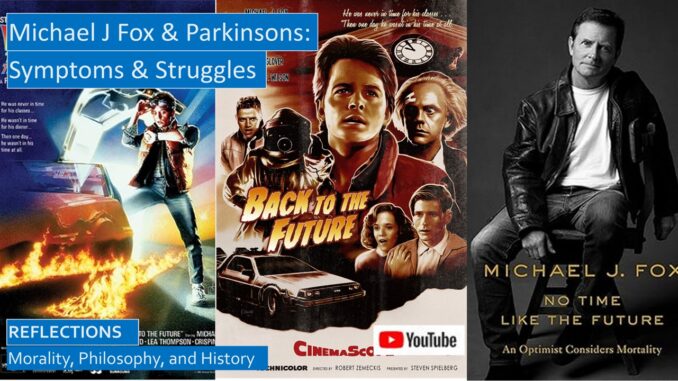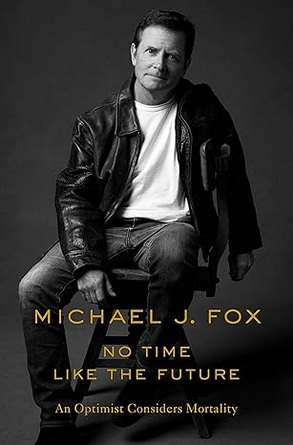
How did Parkinson’s disease change Michael J Fox’s life?
Was he still able to have an acting career while suffering from Parkinson’s?
How does Parkinson’s compare and contrast with other neurological diseases?
What are the common challenges faced by Parkinson’s patients?
Michael J Fox begins his biography with this lament as he stumbles: “I’m going down. It’s a flash fall. Vertical to horizontal in a blink. I twist my head to save my face from colliding with the kitchen tile. What the hell just happened? I rise up on my right elbow, expecting to shift my weight to the left and push up onto my feet. Surprise: I can’t feel my left arm.”[1]
MICHAEL J FOX AND PARKINSON’S DISEASE
By the time he wrote his memoir in 2020, No Time Like the Future, with the subtitle, An Optimist Considers Mortality, Michael J Fox had lived with Parkinson’s Disease for about thirty years. Subsequently, his condition has deteriorated, and to be honest, I find it painful to listen to him in his recent interviews, as his speech is so slurred that it is difficult to understand him.


Where does Parkinson’s disease fall on the spectrum of neurological diseases? On one extreme, dementia, including Alzheimer’s disease, degrades the patient’s cognition, including memory and reasoning. Their motor functions decline only as their overall health declines. On the other extreme, ALS or Lou Gehrig’s disease degrades the patient’s motor functions, often starting with the legs, then the arms, then they have trouble breathing.
Parkinson’s disease falls somewhere in between. Often it manifests as trembling or shaking, then swaying, attacking the motor functions. Whereas ALS patients often survive for less than five years after their diagnosis, Parkinson’s patients can live for decades after diagnosis. There are also many more treatment options for Parkinson’s patients than for either dementia or ALS patients which apparently slows the progression of the disease.[2]
Some patients suffering from Parkinson’s disease and a particular type of dementia develop Lewy Bodies, which are abnormal protein deposits that build up in the brain nerve cells. The affected Parkinson’s patients first suffer from motor function decline, but some time, or some years later they also suffer from cognitive decline. In contrast, patients suffering from Lewy Body dementia first suffer cognitive decline, then later suffer from motor function decline.[3]
This is how Michael Fox describes the disease: “Parkinson’s, for obvious reasons, is primarily thought of as a movement disorder; resting tremor, slowness, or bradykinesia,” which is the slowing down of voluntary actions, like finger-tapping. “For us long-timers, walking and balance are a bitch. Parkinson’s is also a non-movement disorder, with changes in mood and sleep, fatigue, difficulty speaking, as well as digestive tract issues. When our behavior even hints at any of these changes, we first try to attribute them to aging, or more often, we just keep it to ourselves.”
Michael Fox continues: “To me, movement always represented my freedom.” After several years, he fully realized this was truly a movement disorder. “Mine is not a mental or emotional disorder.” “It is a neurological” “corruption of movement. Some people will focus on the slight palsy, the tremoring of fingers and limbs,” which can be manageable. “Much more difficult to acknowledge and accept is the diminishment of movement.” Without drugs, “Parkinson’s renders me frozen, immobile, stone-faced, and mute: entirely at the mercy of my environment. For someone for whom motion equals emotion, vibrancy, and relevance, it is a lesson in humility.”
Fox concludes: “If I don’t know I can do something physically, I just pretend I can. Fake it until I make it. Eight times out of ten, it works. The remaining twenty percent? Stitches, broken bones, humiliation.”[4] Later in his biography, he recalls how he once lost his balance and fell, breaking his arm.[5]
Michael Fox recalls: “A Parkinsonian condition I rarely contemplated before now, much less spoke of, is cognitive change: loss of memory, confusion, delusions, and dementia. What am I thinking, and how am I thinking?” “Where are my car keys? Oh, yeah, I can’t drive anymore.”[6]
MICHAEL J FOX BIOGRAPHY
While on vacation in the Turks and Caicos Islands in 1991, Michael J Fox did not feel right. His limbs felt weak, he experienced spasms and sharp pains, and he felt a slight tremor in his finger. Although he was not yet thirty years old, his neurologist diagnosed him with young-onset Parkinson’s disease.[7]
Michael Fox had been a successful child actor and was enjoying a successful career when he was diagnosed with Parkinson’s. Initially, he developed a bad habit of drinking too much to dull the pain but soon kicked this habit. His infant son had been born a few years earlier, and for the sake of his family, he resolved to live as normal a life as possible. Michael with his wife Tracy planned to have another child, and she gave birth to twins.[8] Many years later, when he was in his forties, Michael Fox learned how to play golf, even though his Parkinson’s interfered with his coordination.[9]
In the years preceding his diagnosis, Michael Fox starred in the Back To The Future film trilogy, where his character, Marty Fly, was a time traveler. In the decade after his diagnosis, he starred in about a half-dozen movies. In 1996, he starred in the TV series Spin City, where he played the deputy mayor of a fictional New York City. When his condition worsened by 1998, he made public his struggle with Parkinson’s disease, compelling him to leave the Spin City cast. Parkinson’s started to rob his face of his natural expressiveness, which was so important for his acting technique.[10]
Later, Michael Fox remembers: “In retrospect, I may have jumped the gun. My situation was evolving in unexpected ways. During my last season on Spin City, I was tremoring and swaying with dyskinesias,” which includes tics, tremors, and other uncontrollable movements. He found a specialist who reworked his drug and treatment plan, placing more emphasis on physical therapy, diet, and fitness, which modestly improved his health for a few years.
Since these new treatments helped hold the deterioration of his symptoms, Michael Fox accepted many supporting roles, and he played a disabled person in some of these roles. But, in 2020, he cut back on acting as his speech and pronunciation deteriorated.[11]
In the year 2000, he founded the Michael J Fox Foundation which provides grants to scientists searching for a cure for Parkinson’s. In 2006, it was the largest private funder of research for the disease, by 2022 it contributed more to this research than did the federal government.
SYMPTOMS AND STRUGGLES WITH PARKINSON’S
Michael Fox’s doctors discovered a tumor in his spinal cord. They assured him that this tumor was unrelated to his Parkinson’s, but how could they be sure? His wife asked the doctor whether he thought that an operation to remove his tumor would be successful.
Doctor Theodore stated: “Success means there will be no further progression.” “The goal is not to fix anything that has already been damaged, that will be impossible. Serious balance issues will persist, and there is no cure for your cramping.”[12]
When my mother developed Lou Gehrig’s disease, she asked if she would improve if a cure were found. The doctor’s answer was similar, more than likely any “cure” would stop the progression of the disease.
If you suspect you may have neurological symptoms, do have them checked out, even if they are minor. For example, I am getting older and had some problems with headaches, though it was unclear whether these were worse than those I have suffered all my life. After discussing the fact that aneurysms and strokes can strike with little warming, my doctor decided that it would be wise to have my head examined, and the results confirmed that I had little to worry about.
For many neurological diseases, there are other conditions, such as brain tumors, that have similar symptoms, and sometimes when these are resolved not only is the progressive deterioration halted, but there can be substantial improvement in your health. Plus, there are treatments that can alleviate the symptoms of Parkinson’s disease, greatly improving your quality of life.
Exercise is critical for Parkinson’s patients. Michael Fox is fortunate in that he worked out with a physical therapist for an hour every day when he was still somewhat mobile. Fox recounts his routine: First, “core work, crunches, sit-ups, bicycle kicks, the dreaded ab chair: we always start out with the fun stuff.” Then toe touches, followed by “treadmill, rowing machine, and a selection of stretching exercises.”[13]
Everything is a challenge with Parkinson’s. Due to his age and his disability, Michael Fox needed to go to the bathroom twice most nights. He notes: “At home, I’m familiar with the terrain from bed to bathroom, and slowly and somewhat shakily make my way safely to and fro each time. I lean on walls, doing what my occupational therapist calls ‘furniture surfing’: reaching out and touching furniture in my path, not so much for support” but to find my way.[14]
Michael Fox rues that after thirty years of suffering from Parkinson’s, “my mobility and balance have definitely worsened. I struggle with consistency, establishing and maintaining a steady rhythm in my gait,” “Standing for any length of time is a wobbly proposition.”[15]
DISCUSSING THE SOURCES
We enjoyed reading about Michael J Fox’s growing struggles with Parkinson’s, what went through his mind, and how he strove to live as fully as possible. We were also fascinated with his description of how the other half lives, how movie actors frequent vacation resorts that charge many times more than what mere mortals like me can afford.
We also enjoyed reading the biography of another celebrity, Glen Campbell, and his struggles with dementia as remembered by his wife Kim. His story was more dramatic, as it told the story of his last tour, and how the songs on his last album traced his frustrations with Alzheimer’s disease. Michael J Fox also played a decent guitar, but not well enough to stage a final concert.
Glen Campbell Suffering from Alzheimer’s, Early Signs and Symptoms
https://seekingvirtueandwisdom.com/glen-campbell-suffering-from-alzheimers-early-signs-and-symptoms/
https://youtu.be/F9NmDiiPowI
Michael Fox observed: “I have at least two things in common with Franklin Delano Roosevelt:”
- “The covert use of a wheelchair.”
- “A fear of fear,” which recalls FDR’s Inaugural Address when the country was in the early grips of the Depression: “The only thing we have to fear is fear itself.”[16]
When we are elderly and can no longer live on our own, whether we suffer from diseases like Parkinson’s or dementia, or whether old age catches up with us, we feel a loss of control now that others are our caretakers.
Michael Fox remembers how he showed his youngest son, Sam, who was born before his Parkinson’s diagnosis, “how to tie his shoes, using the rabbit method,” and “how to ride a bike, gently pushing from behind as he found the confidence to press the pedals and gather speed. Now, on occasion, Sam pushes me: in a wheelchair.” “When I rise carefully from the chair, my son often checks my laces before I take a step, and he’s quick to tie them for me, if needed.”[17]
[1] Michael J Fox, No Time for the Future, Introduction, p. 1.
[2] https://en.wikipedia.org/wiki/Parkinson%27s_disease
[3] https://en.wikipedia.org/wiki/Lewy_body and https://en.wikipedia.org/wiki/Parkinson%27s_disease_dementia and https://en.wikipedia.org/wiki/Dementia_with_Lewy_bodies and https://en.wikipedia.org/wiki/Lewy_body_dementia
[4] Michael J Fox, No Time for the Future, Chapter 6, Loco Motion, p. 65.
[5] Michael J Fox, No Time for the Future, Chapter 14, Breaking Dad, pp. 144-145.
[6] Michael J Fox, No Time for the Future, An Optimist Considers Mortality (New York: Flatiron Books, 2020), Chapter 20, Father Time, pp.189-190 and https://en.wikipedia.org/wiki/Hypokinesia#Bradykinesia
[7] Michael J Fox, No Time for the Future, Chapter 8, Exile on Pain Street, pp. 83-84.
[8] Michael J Fox, No Time for the Future, Chapter 1, Family Man, pp. 5-7.
[9] Michael J Fox, No Time for the Future, Chapter 5, Double Bogey, p. 55.
[10] https://en.wikipedia.org/wiki/Michael_J._Fox
[11] Michael J Fox, No Time for the Future, Chapter 3, Act Too, pp. 21-22 and https://en.wikipedia.org/wiki/Michael_J._Fox
[12] Michael J Fox, No Time for the Future, Chapter 15, A Wing and a Proverb, p. 93.
[13] Michael J Fox, No Time for the Future, Chapter 7, Unsafe at Any Speed, pp. 69-71.
[14] Michael J Fox, No Time for the Future, Chapter 19, The Only Thing to Fear, p. 185.
[15] Michael J Fox, No Time for the Future, Chapter 7, Unsafe at Any Speed, p. 75.
[16] Michael J Fox, No Time for the Future, Chapter 19, The Only Thing to Fear, p. 179.
[17] Michael J Fox, No Time for the Future, Chapter 1, Family Man, p. 5.




Be the first to comment